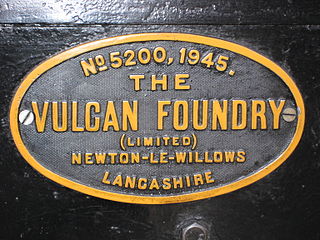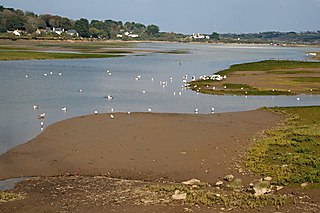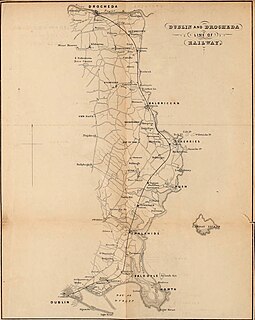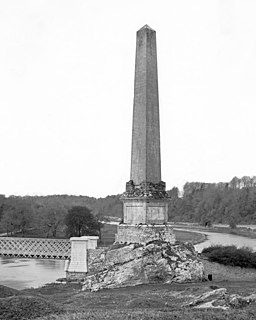
Drogheda is an industrial and port town in County Louth on the east coast of Ireland, 56 km (35 mi) north of Dublin. It is located on the Dublin–Belfast corridor on the east coast of Ireland, mostly in County Louth but with the south fringes of the town in County Meath, 49 km (30 mi) north of Dublin. Drogheda has a population of approximately 41,000 inhabitants (2016), making it the eleventh largest settlement by population in all of Ireland. It is the last bridging point on the River Boyne before it enters the Irish Sea. The UNESCO World Heritage Site of Newgrange is located 8 km (5.0 mi) west of the town.

John Rennie FRSE FRS was a Scottish civil engineer who designed many bridges, canals, docks and warehouses, and a pioneer in the use of structural cast-iron.

The Dublin Area Rapid Transit system is an electrified commuter rail railway network serving the coastline and city centre of Dublin. The service makes up the core of Dublin's suburban railway network, stretching from Greystones, County Wicklow, in the south to Howth and Malahide in north County Dublin. The DART serves 31 stations and consists of 53 route kilometres of electrified railway, and carries in the region of 20 million passengers per year.

Dublin Port is the seaport of Dublin, Ireland, of both historical and contemporary economic importance. Approximatively two-thirds of Ireland's port traffic travels via the port, which is by far the busiest on the island of Ireland.

The Vulcan Foundry Limited was an English locomotive builder sited at Newton-le-Willows, Lancashire.

O'Connell Bridge is a road bridge spanning the River Liffey in Dublin, and joining O'Connell Street to D'Olier Street, Westmoreland Street and the south quays.

Hayle is a port town and civil parish in west Cornwall, United Kingdom. It is situated at the mouth of the Hayle River and is approximately seven miles (11 km) northeast of Penzance.

The Hayle Estuary is an estuary in west Cornwall, England, United Kingdom. It is one of the few natural harbours on the north coast of south-west England and during the prehistoric and early medieval periods was important for trade and the movement of people and ideas.
Grendon, meaning Green Hill (Don) or Green Valley (Dene) in Old English, may refer to:

Dublin and Drogheda Railway (D&D) was a railway company in Ireland which publicly opened its 31¾ mile main line between Dublin and Drogheda in May 1844. It was the third railway company in Ireland to operate passenger trains and the first to use the Irish standard 5 ft 3 in gauge. It later opened branches to Howth and Oldcastle. The opening of the Dublin and Belfast Junction Railway (D&BJct) between the D&D at Drogheda and the Ulster Railway (UR) at Portadown in 1852 saw an almost continuous main line connection between Dublin and Belfast, which was resolved by the official opening of the Boyne Viaduct in April 1855. Amalgamations between these and other companies in 1875 and 1876 saw the creation of the Great Northern Railway of Ireland GNR(I).

Dublin and the Belfast Junction Railway was an Irish gauge railway in Ireland. The company was incorporated in 1845 and opened its line in stages between 1849 and 1853, with the final bridge over the River Boyne opening in 1855. It linked the Ulster Railway (UR) from Belfast to Portadown and Dublin and Drogheda Railway (D&D) from Drogheda to Dublin, completing the missing link in the Dublin to Belfast main line.
There are seven bridges in and around Drogheda, Ireland.

Sir John Rogerson's Quay is a street and quay in Dublin on the south bank of the River Liffey between City Quay in the west and Britain Quay. Named for politician and property developer Sir John Rogerson (1648–1724), the quay was formerly part of Dublin Port. It has some of the few remaining campshire warehouses in Dublin.

Britain Quay is a street and quay in Dublin on the south bank of the River Liffey between Sir John Rogerson's Quay and the confluence of the River Liffey, River Dodder and Grand Canal.
Bindon Blood Stoney FRS was an Irish engineer who also made some significant contributions to astronomy.
Joseph Booth & Bros was an English company notable for making cranes used in large construction projects.

The North Bull Lighthouse, is an active aid to navigation located at the mouth of the River Liffey, near Dublin, Ireland. It is one of four lighthouses that help guide shipping into the Liffey, and the Port of Dublin, all of which are operated and maintained by the Dublin Port Company.
Midland Great Western Railway (MGWR) Classes 6,8,10,11,17 and 18 were 2-4-0 locomotives introduced in the period 1852-1870. The 22 locomotives were spread across 6 different manufacturers and all were withdrawn in the decade between 1880 and 1890 though some donated parts to other builds at Broadstone Works.

The Boyne Obelisk, also known as King William's Obelisk, was an obelisk located in Oldbridge, near Drogheda, County Louth, Ireland.

The North Bank or Northbank Lighthouse, is an active aid to navigation located at the mouth of the River Liffey, near Dublin, Ireland. It is one of four lighthouses that help guide shipping into the Liffey, and the Port of Dublin, all of which are operated and maintained by the Dublin Port Company. Built in 1882, it also affectionately called The Tea Caddy due to its architecture, and has also been described as "resembling a giant mailbox on stilts".
















